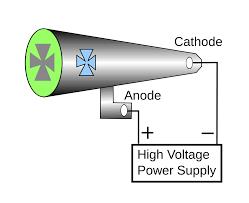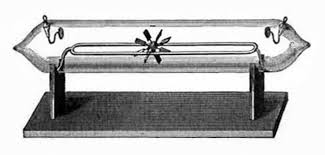Class 11 Chemistry
Structure of Atom

DISCOVERY OF ELECTRON:
The Electron was discovered by J.J Thomson by conducting a Cathode ray tube experiment.
For the experiment he used Crooke’s tube, which was 60cm long glass tube and had a small tube attached. To this small tube vacuum pump was attached, it also had two metal plates which were connected to battery by wires.

The tube contained gas at atmospheric pressure. when current at high voltage (10,000volts) was passed following observations were made:
- When current was passed through a gas at 1 atmospheric pressure and at a very high voltage, nothing happened. That is no visible effect was seen inside the tube.
- Then further the pressure of gas was reduced by pumping the air out, with the help of vacuum pump. The pressure was reduced to 10-2atm, then on passing current it was seen that whole tube started glowing green.
- Then further the pressure was reduced to 10-4It was seen the whole glow vanished, but it was seen that at the end of the tube (anode side) there was a faint green glow observed.
To confirm the faint glow anode was made perforated, and a zinc sulphide screen (fluorescent material) was placed behind it.
When current was passed under same conditions it also started glowing green. This confirmed that under those conditions some rays were emitted through cathode, and were travelling towards anode. Those rays were called as cathode rays and found to consist of negatively charged particles called electron.
Properties of cathode rays
- They are found to travel in straight line. This property was concluded by performing an activity where the object was placed in their path. When they strike it ,they casted the shadow of the object as shown below:

- Cathode rays are formed of material particles. This property was concluded by performing an activity where in their path a paddle was mounted on an axle.When they strike it ,they rotated the paddle .

- They are negatively charged.This property was concluded by performing an activity where electric and magnetic field was applied, they deflected towards positive plate and in presence of magnetic field they deflected towards north pole.

- When they strike some metal surface, they heated it. So, it was concluded they can also produce heating effect.
- They cause ionization of gas through which they passed.
- They produce x-rays when strike against the hard metal like tungsten etc.
- They can make florescent material glow, when strikes some fluorescent material.
- They affect the photographic plate.
- They have penetrating effect.
From the above properties and experiment it was concluded that cathode rays are made up of negatively charged particles called electron.
Further experiments were carried out in order to know the charge and mass of electron. It was found to be:
- Charge :1.6 x 10-19C
- Mass 9.1 x 10-31kg
We can define electron as:
- “A fundamental particle that is negatively charge of magnitude 1.6 x 10-19C and mass equal to 9.1 x 10-31
Class 11 Chemistry Structure of Atom NCERT Chapter 2 Free Notes for Best Revision
Revision of Class 11 Chemistry Structure of Atom is a crucial aspect of effective learning. Revision plays a vital role in the learning process and is especially important before exams. Here are some key points you can consider emphasizing in your content:
- Retention and Memory: Regularly reviewing and revisiting the material of Class 11 Chemistry Structure of Atom helps reinforce the concepts in students' minds. It strengthens memory pathways, making it easier to recall information during exams and beyond.
- Consolidation of Knowledge: When you revise notes, you are essentially consolidating your knowledge. This means connecting new information with what you already know, making the overall understanding more robust.
- Identifying Knowledge Gaps: Revision allows students to identify any gaps in their understanding or areas where they need further clarification. This gives you a chance to seek help or delve deeper into those topics. For detailed understanding, you can always refer to the videos of Structure of Atom Class 11 Chemistry NCERT Chapter 2 on LearnoHub.com
- Building Confidence: As you revise Structure of Atom Class 11 Chemistry and become more familiar with the content, your confidence in your abilities grows. Confidence is a crucial factor in exam performance as it reduces anxiety and allows you to approach exams with a positive mindset.
- Different Revision Techniques: Use a variety of revision techniques such as summarizing notes, creating flashcards, practicing past papers, discussing concepts with peers, and teaching others. Different techniques work for different students, and it's essential to find what suits you the best. You can also attend the LIVE Revision classes on LearnoHub.com or watch the LIVE Revision Race videos of LearnoHub on Structure of Atom Class 11 Chemistry NCERT Chapter 2.
- Spacing Effect: Spacing out revision sessions over time, rather than cramming all at once, has been shown to improve long-term retention. Create a revision schedule leading up to the exams to allow for spaced practice.
- Regular Revision over Cramming: Regular and consistent revision throughout the academic year is very important. Waiting until the last moment to cram everything can be overwhelming and less effective than spaced-out revision.
- Self-Assessment: Assess your understanding periodically through quizzes or self-tests. This helps you to gauge your progress and identify areas that need further attention. Refer Class 11 Structure of Atom Online Tests.
- Balanced Approach: Remind students to strike a balance between revision and other activities. Adequate rest, exercise, and relaxation are essential for optimal learning and performance.
- Seeking Help: If you face difficulties during the revision process, Refer the videos of Class 11 Chemistry Structure of Atom. Clearing doubts promptly is crucial for a better grasp of the subject matter. You can always ask your doubts on Structure of Atom Class 11 Chemistry NCERT Chapter 2. “Ask a Question” section of LearnoHub.com
By highlighting the benefits and strategies of effective revision, you can approach your studies more mindfully and achieve better results in your exams. Best of luck bachhon!
Class 11 Chemistry seems to be a quite difficult subject for a lot of students. But, if you get a very good conceptual understanding of the subject, it can be very interesting for you.
We, at LearnoHub, will give our best to make Class 11 Chemistry Structure of Atom NCERT Chapter 2 super-duper easy for you.
We aim at making learning fun as well as engaging for you with our complete end-end learning content with Structure of Atom Class 11 Chemistry Best videos, Notes, NCERT pdf, NCERT complete syllabus, tests and Practice Questions.
Always remember, it is very important to study with full concentration during Revision. Here are a few tips for you on how to revise with full focus:
- Create a Distraction-Free Environment: Find a quiet and comfortable place to study where you can minimize distractions. Turn off or silence your phone, log out of social media accounts, and inform others around you that you need uninterrupted study time. A dedicated study environment will help you focus better.
- Set Specific Goals: Before starting your study session, set clear and achievable goals. Break down your study material into smaller tasks, and plan what you want to accomplish during each session. Having specific goals will give you a sense of direction and purpose, making it easier to concentrate.
- Use the Pomodoro Technique: The Pomodoro Technique is a time management method that involves studying in short, focused intervals, typically 25 minutes, followed by a short break of 5 minutes. After completing four sessions, take a longer break of around 15-30 minutes. This technique can improve focus and productivity by providing regular breaks to recharge.
- Stay Organized: Keep your study materials, notes, and resources well-organized. Having everything you need at hand will save time and reduce distractions caused by searching for materials. Use color-coded folders or digital tools to maintain a structured study system.
- Practice Mindfulness and Meditation: Before you begin studying, take a few minutes to practice mindfulness or meditation. Deep breathing exercises and clearing your mind of distractions can help you approach your study session with a calm and focused mindset.
Remember, studying with full concentration is a skill that takes time and practice to develop. If you find your mind wandering during study sessions, gently bring your focus back to the task at hand and be patient with yourself. With consistent effort, you can improve your ability to concentrate and make the most of your study time.
Last but not the least, To get the best hold on Class 11 Chemistry Structure of Atom Book Chapter 2. Do not forget to check out:
- Structure of Atom Class 11 Chemistry Best videos
- Structure of Atom Class 11 Chemistry NCERT Solutions
- Class 11 Chemistry Structure of Atom Revision notes
- Structure of Atom Class 11 Chemistry DPPS, Download PDF of solutions
- Class 11 Chemistry Structure of Atom Online Tests
- Class 11 Chemistry Sample papers